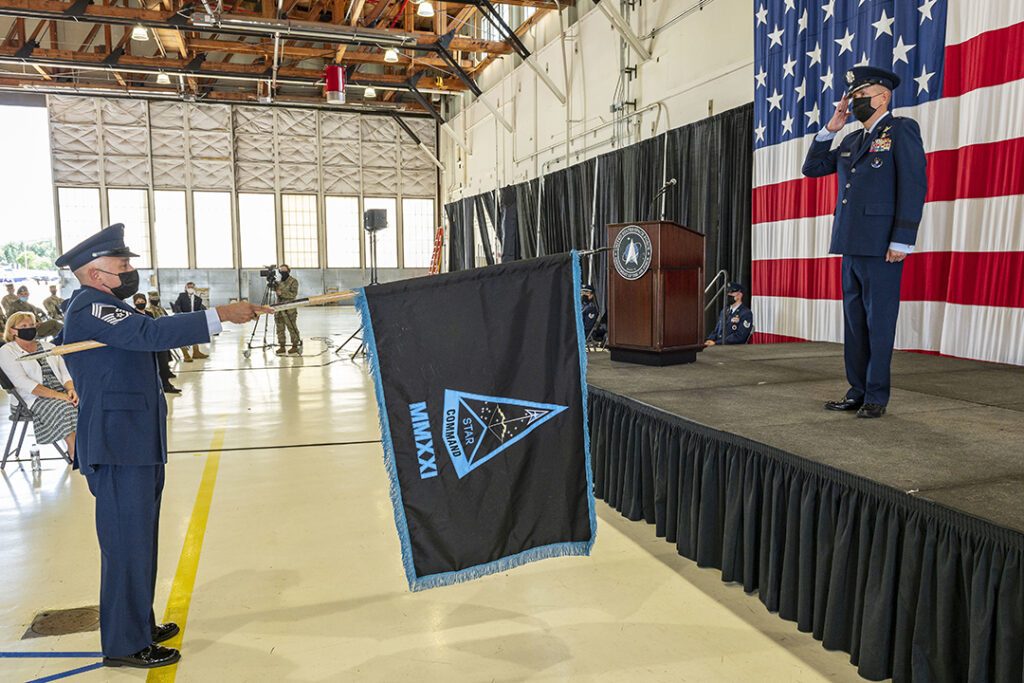THE WATCH staff
The U.S. Space Force (USSF) is quickly coming of age.
The military service is poised to launch its warfighting capability less than two years since itscreation after the activation of its third and final field command — the Space Training andReadiness Command (STARCOM) — during a ceremony August 23, 2021, at Peterson SpaceForce Base in Colorado Springs, Colorado.
Congress established the new service, which is part of the Department of the Air Force, in 2019and sought for it to become operational in 18 months, a deadline it met this summer, according tothe Air Force Times. In addition, the USSF announced recently it had reached other milestones— establishing its social-media presence and meeting a benchmark for a new satellite system.
Currently, about 6,000 uniformed Space Force Guardians and 6,000 civilian employees serve in the USSF, which relies on an additional 6,000 or so Airmen who work in support roles such as base security, according to the Air Force Times.

Now, with STARCOM, the service is ready to prepare its Guardians through education, training, doctrine and tactics, according to United Press International (UPI). Air National Guard Brig. Gen. Shawn Bratton assumed command of STARCOM during the August ceremony. (Pictured:
Bratton receives his first salute as commander during the ceremony.) “You are developing the doctrine that will shape the next century of space as an operational and independent domain,” U.S. Space Force Gen. John W. “Jay” Raymond, chief of space operations, said during the ceremony, according to Air Force Magazine. “You are where the rubber meets the road in establishing a cohesive, unified cadre of space warfare professionals.”
The service’s other core commands are the Space Operations Command, which was activated in October 2020, and the Space Systems Command, activated in July 2021. The Space Force in October plans to accept its first U.S. military members as Guardians from outside the Air Force and absorb some of their services’ missions into the USSF, according to a story in the Air Force Times.
The Space Force will take on wideband satellite communications in the Army and narrowband operations in the Navy — pending congressional passage of a defense budget by October 1, the start of fiscal year 2022, according to Vice Chief of Space Operations Gen. David “DT” Thompson, the Air Force Times reported.
When it comes to filling its ranks, the Space Force, which in August launched its own recruiting Twitter and YouTube accounts, “could flip the typical military staffing model” as the Air Force Times said in the August 19 story.
While the other armed services rely on a regular stream of young recruits, the USSF needs a larger and more experienced force of Guardians who understand the intricacies of space, Thompson said. The Space Force’s upcoming human capital plan pushes Guardians to pursue cutting-edge technical education, according to the Air Force Times.
“For engineers, it might be advanced degrees. For operators, it might be, everyone is required [to have] some level of advanced training,” Thompson said in the August 19 story.
To that end, the service’s new recruitment video — motto: “The sky is not the limit” — was unveiled during the 36th Space Symposium held August 23-26 in Colorado Springs.
The video includes Raymond, the service’s chief, who gave the symposium’s keynote address. The general emphasized that space operations are crucial to everyday life and to national defense. “We’ve gone from about 2,100 active satellites on orbit in 2019 to approximately 4,900 today,”
Raymond said, according to a release from the Air Force News Service (AFNS). “That’s astounding — while we’ve been wearing masks, the number of active satellites has doubled,” he said, referring to the coronavirus pandemic. Also during the symposium, the USSF announced that the latest missile-warning satellites have passed a critical design review. The Next Generation Overhead Persistent Infrared (Next Gen OPIR) program will place five satellites in orbit, including two in highly elliptical orbits for polar coverage, according to Defense News. The first satellite in the Next Gen OPIR system is expected to launch in 2025.
In his symposium keynote (pictured), Raymond pointed out the accelerating space presence of potential adversaries. “Over the last two years, China and Russia have continued to build an entire spectrum of threats,” he said, according to the AFNS. But such challenges are also helping to attract talented personnel, Raymond said, according to the AFNS.
“People are excited about what we’re building in the Space Force,” he said, “and they want in.”
IMAGE CREDIT: STAFF SGT. KIRSTEN BRANDES/U.S. SPACE FORCE

